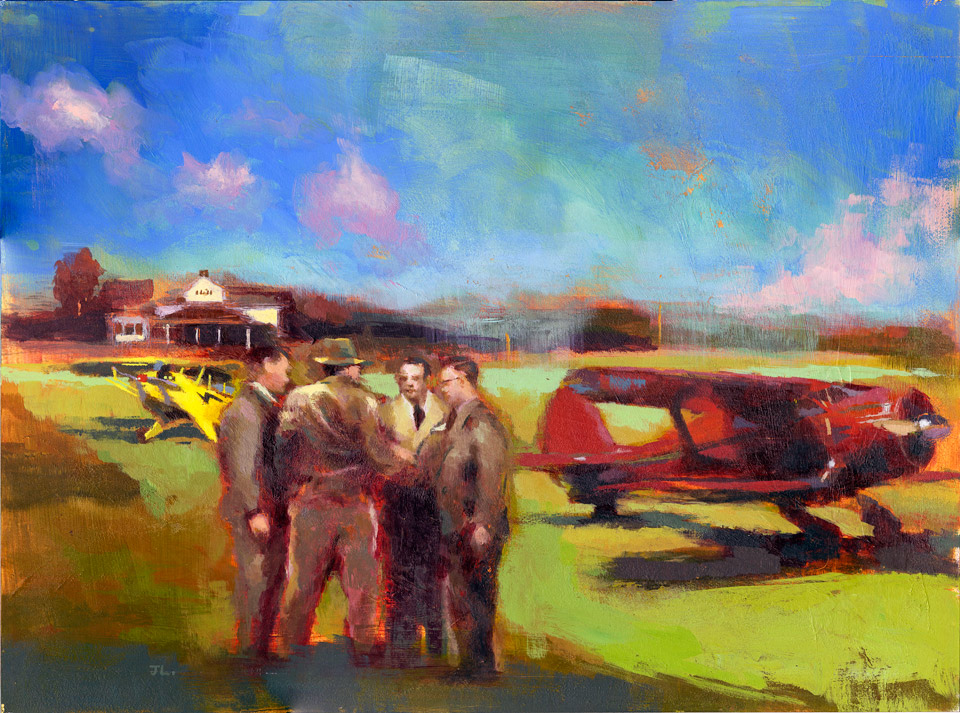
Illustration by Jerome Larrigue
The Pylon Club—a flying club based at Patco Field in Norristown, Pennsylvania—was having another of its fly-outs. This one was to a private island in the Saint Lawrence River, owned by brothers Philip T. and Laurence P. Sharples, industrialists specializing in the manufacture of centrifuges. For unknown reasons, the Sharples brothers got lost en route and took a while to sort things out. By the time they neared the island it was becoming dark, so they landed at a friend’s airport and spent the night. That friend was Edwin Link, the inventor of the Link trainer. Link’s houseguest was Edward J. Noble, soon to become the chairman of the Civil Aeronautics Authority (CAA), the forerunner of the Federal Aviation Administration. It was autumn 1937.
By the time the Sharples brothers met Noble again, they had been busy exploring the idea of forming a pilot’s association with like-minded Pylon Club members. One of them, Philadelphia lawyer Alfred L. Wolf, had written a letter to Carl Friedlander, president of the Aeronautical Corporation of America (Aeronca). Friedlander had written an article for The American Aviation Daily in which he argued for an association to represent the interests of private airplane manufacturers, and Wolf agreed. “The world of the airline plane, and the world of the military plane, was a different world than the one in which Carl was making his Aeroncas,” Wolf said.
There were parallels in the pilot world—for example, the Private Fliers Association (PFA) and the Sportsman Pilots Association (SPA)—but Wolf felt that the SPA was just for fun, and that the PFA “wanted to be all things to all men in aviation,” according to one letter. Other groups proved equally ineffective, and made for a confusing scene that divided interests instead of uniting them. There was the American Pilots League, the Private Pilots Association, the United Pilots and Mechanics Association, and the Association for the Advancement of Aeronautics. Without a more focused, businesslike organization, Wolf and his compatriots feared that “miscellaneous aviation”—as general aviation was called then—would come out second best in political battles unless it had a better lobbying organization.
Those compatriots—all from the Philadelphia area—included Wolf, C. Townsend Ludington (owner of The Ludington Line, an air shuttle service that flew between Newark and Washington), the Sharples brothers, and John Story Smith (secretary-treasurer of the Jacobs Aircraft Engine Company).
Meanwhile, a student at the University of Pennsylvania was busy networking. Joseph B. (“Doc”) Hartranft Jr. had made a name for himself at a very young age as a founder of the National Intercollegiate Flying Club (NIFC, now known as the National Intercollegiate Flying Association), and founder and president of the “Cloudcombers”—the university’s flying club. Hartranft invited Wolf to speak at a NIFC convention, and Hartranft gave his own talk—about the need for a national association to represent general aviation pilots.
With this in common, Wolf took the next step. He invited Hartranft to a meeting with the Philadelphia group. It was the first time the nervous, 22-year-old Hartranft met all the principals in this influential group, but the meeting aligned their convictions. However, it was another fly-out in late 1938 that brought the group encouragement to formalize their resolve.
This time, the Sharples brothers flew Edward Noble, by now chairman of the CAA, to southern Georgia for a turkey-hunting expedition. While waiting in a blind for the turkeys to show up, Noble told the Sharpleses how the airline and military lobbyists came to the CAA with professionally executed, very convincing arguments for their positions—and usually got their way. Private pilots usually came one by one to the CAA with their grievances, coming across as undisciplined oddballs—and, Noble said, confirming the image of private flying as a lunatic fringe. He said that without a single, coherent voice, general aviation interests would always be in jeopardy.
Wolf heard essentially the same thing in April 1939 from Edward P. Warner, a sympathetic CAA board member, who said, “Though private fliers think private flying is very important, no one else is convinced of that, and whenever anyone comes for government cooperation or assistance, they are faced with a lack of proof that there is anything beyond a luxury involved…someone must set out to prove the relationship between the type of flying we are going to represent and the national economy, the national defense, etc.”
When word of Noble’s and Warner’s opinions reached the Philadelphia group, they decided to act. After all, here was the government, the organization that had caused general aviation all of its troubles, giving advice on how it best could be influenced.
But first there was the matter of deciding this new organization’s name. Philip T. Sharples favored “Pilots, Incorporated,” arguing that this conveyed a more professional approach. Laurence Sharples, Ludington, Smith, and Wolf each had their own ideas. As the meeting droned on at Philadelphia’s Barclay Hotel, the clock reached 2:30 a.m., and C. Townsend Ludington had had enough. “I’m tired, and I’m going to bed,” he said. “I propose we name it just what it is—the Aircraft Owners and Pilots Association.”
The deal was done. On May 15, 1939, AOPA’s charter was signed. The Sharples brothers, Ludington, Wolf, and Smith became the founding trustees of the infant AOPA. Ludington was elected as AOPA’s first president, and Hartranft was hired as the first employee. By 1952, Hartranft was named president, and by then AOPA was the influential Washington player and voice of general aviation that its founders had hoped for. And it has continued growing in influence since then.
Email [email protected]



